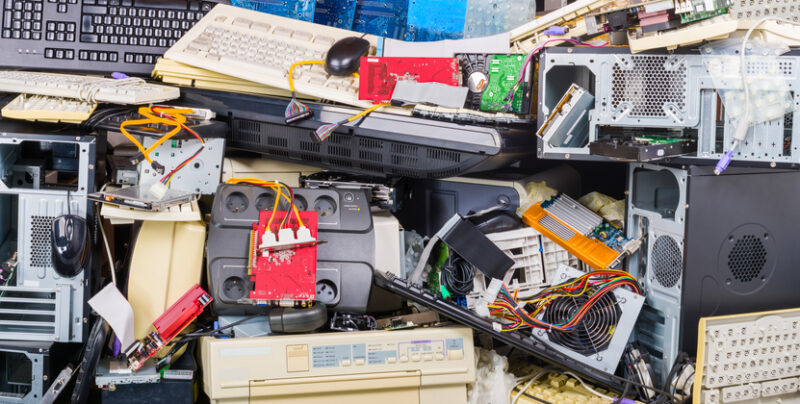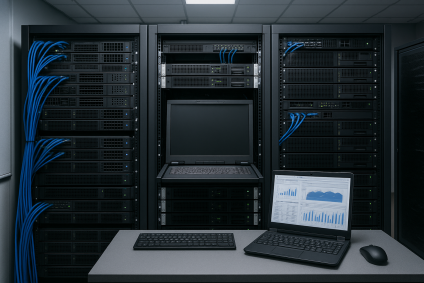E-Waste Disposal: A Pressing Issue
Published on 4/20/2022 – Updated on 12/11/24
E-waste refers to electronic products that are no longer in use such as computers, smartphones, telephones, TVs, and printers. The world generated 53.6 million metric tons of e-waste in 2019, according to the United Nations, and it’s expected to grow more in the coming years.
This massive pile of waste threatens the environment and human health because of the hazardous materials it contains like lead, mercury, and other toxic substances. Improper disposal allows these toxins to seep into the soil and water, causing long term environmental damage.
In this article we will cover e-waste disposal dangers, how to recycle and dispose of e-waste safely, and how businesses and individuals can be part of a sustainable future.
E-waste disposal goes beyond being an environmental issue. It’s an opportunity to rethink how we treat our electronics at the end of their life.
Why is E-Waste Disposal Important?
Proper e-waste disposal is essential for the environment and human health.

Source: TheRoundUp
With the fast pace of technology, the volume of discarded electronic products has made responsible handling a must.
Environmental Impact
- Toxic Chemicals in E-Waste: Old computers, cell phones, and TVs contain harmful substances like lead, mercury, and cadmium. When not disposed of properly, these toxins seep into the environment causing permanent damage.
- Water and Soil Pollution: Hazardous chemicals from e-waste can leach into groundwater and contaminate soil, disrupting ecosystems and agricultural productivity.
- Greenhouse Gas Emissions: When electronic products are burned or dumped improperly, they release greenhouse gases and toxic substances contributing to climate change and air pollution.
Health Risks
- Exposure to Toxic Substances: Improper handling of e-waste exposes workers and nearby residents to hazardous materials like mercury and lead which can cause serious health problems.
- Respiratory Problems: Burning e-waste releases harmful chemicals into the air causing respiratory issues and long term lung damage.
- Neurological Disorders: Prolonged exposure to toxins in e-waste has been linked to developmental and neurological disorders, especially in children and vulnerable populations.
By understanding these risks, you can take the necessary steps to reduce the impact of e-waste disposal on our planet and ourselves.
The Toxic Truth: Dangerous Components in E-Waste

The electronics we use daily—both old and new devices—have a dirty little secret: many of them contain toxic substances that can harm the environment and human health if not managed properly.
Here’s a look at the most toxic components in e-waste.
Lead
Lead is often found in batteries, soldering materials, and CRT monitors in older TVs and computer monitors. It can leach into soil and water if not disposed of properly, posing long term environmental damage.
Lead exposure can also cause neurological damage, developmental issues and kidney disease.
Mercury
Mercury is in fluorescent lamps, switches, and can be found in some thermometers.
Mercury released into the environment becomes methylmercury, a toxic substance that accumulates in water bodies and affects aquatic life and humans through the food chain.
Additionally, mercury exposure causes cognitive impairments, tremors, and other neurological disorders.
Cadmium
Cadmium is found in batteries, microchips, and other electronic components. Like lead, cadmium leaches into soil and water from e-waste and can persist for decades.
Cadmium exposure causes lung and kidney damage and increased cancer risk.
Responsible E-Waste Disposal: Best Practices
Improper e-waste disposal can cause environmental and health risks. By following responsible e-waste disposal methods, individuals and businesses can reduce their ecological footprint and create a cleaner, safer world.
Here’s how.
Recycling
Recycling is the best way to manage e-waste responsibly and reduce its environmental impact. Proper recycling means valuable materials are recovered and toxic substances are managed safely.
Choose e-waste recycling programs that are certified to environmental and safety standards like R2 or e-Stewards. Certified recyclers ensure e-waste is handled ethically and sustainably.
Also make sure to check the recycler’s practices to ensure they know how to best manage hazardous materials like lead, mercury and cadmium.
Keep in mind that dismantling separates reusable materials like metals, plastics, and glass from toxic components. By doing so, recycling prevents hazardous waste from entering the environment, and reduces human and wildlife health risks.
Recycling reduces the need for raw material extraction, conserves natural resources, and reduces greenhouse gas emissions.
Donating
Donating old but working electronics is an easy and effective way to manage e-waste and give back to the community. Instead of throwing away your devices to buy new ones, extend its life through donation.
You can do this in the following ways:
- Computers, phones and other electronics that are still working can be refurbished and reused.
- Organizations can fix minor issues to make your old device work for someone else.
- Many non profits and schools accept donations of used equipment like printers, monitors and DVD players to bridge the digital divide.
- Donated electronics can empower individuals, communities, and small businesses who need affordable technology.
- Some charities offer tax deductions for your donations, so supporting good causes becomes both free and rewarding.
By donating your electronics you not only reduce hazardous waste but also help those who can use the technology you no longer need.
Repair and Reuse
Repairing and reusing electronics is a simple way to reduce e-waste and extend the life of your devices. This approach uses no new resources and reduces hazardous waste.
Fixing broken equipment like computers, microwave ovens and phones prevents them from being thrown away too soon. Examples of common repairs include replacing broken screens, upgrading memory, or fixing internal components.
Certified repair centers or DIY repair guides can also help you get your device working again.
You also have the option to refurbish. Refurbished products are professionally repaired and resold or donated to give them a second life. This can include tasks like reinstalling operating systems, upgrading hardware, or thoroughly cleaning and testing the device.
Many refurbished items like phones and TVs work like new at a fraction of the cost, reducing the need for new electronics.
Partner with We Buy Used IT Equipment for Sustainable E-Waste Solutions
Proper e-waste disposal isn’t just an environmental issue—it’s a health and legacy issue. From reducing pollution from lead and mercury to conserving resources through recycling, every bit counts in the global e-waste problem.
At We Buy Used IT Equipment, we are committed to sustainable e-waste solutions that match environmental best practices. We will reuse or safely dispose of your old equipment, computers, printers, and other electronics through certified processes.
So, why us?
- Sustainability First: We reduce hazardous waste and maximize reuse.
- Easy Service: Simplified collection, sorting, and disposal of your e-waste.
- Competitive Pricing: Get value back from your old devices and support green practices.
Ready to make a change with your e-waste?
Contact us today for a quote and start the journey to a cleaner greener tomorrow!







